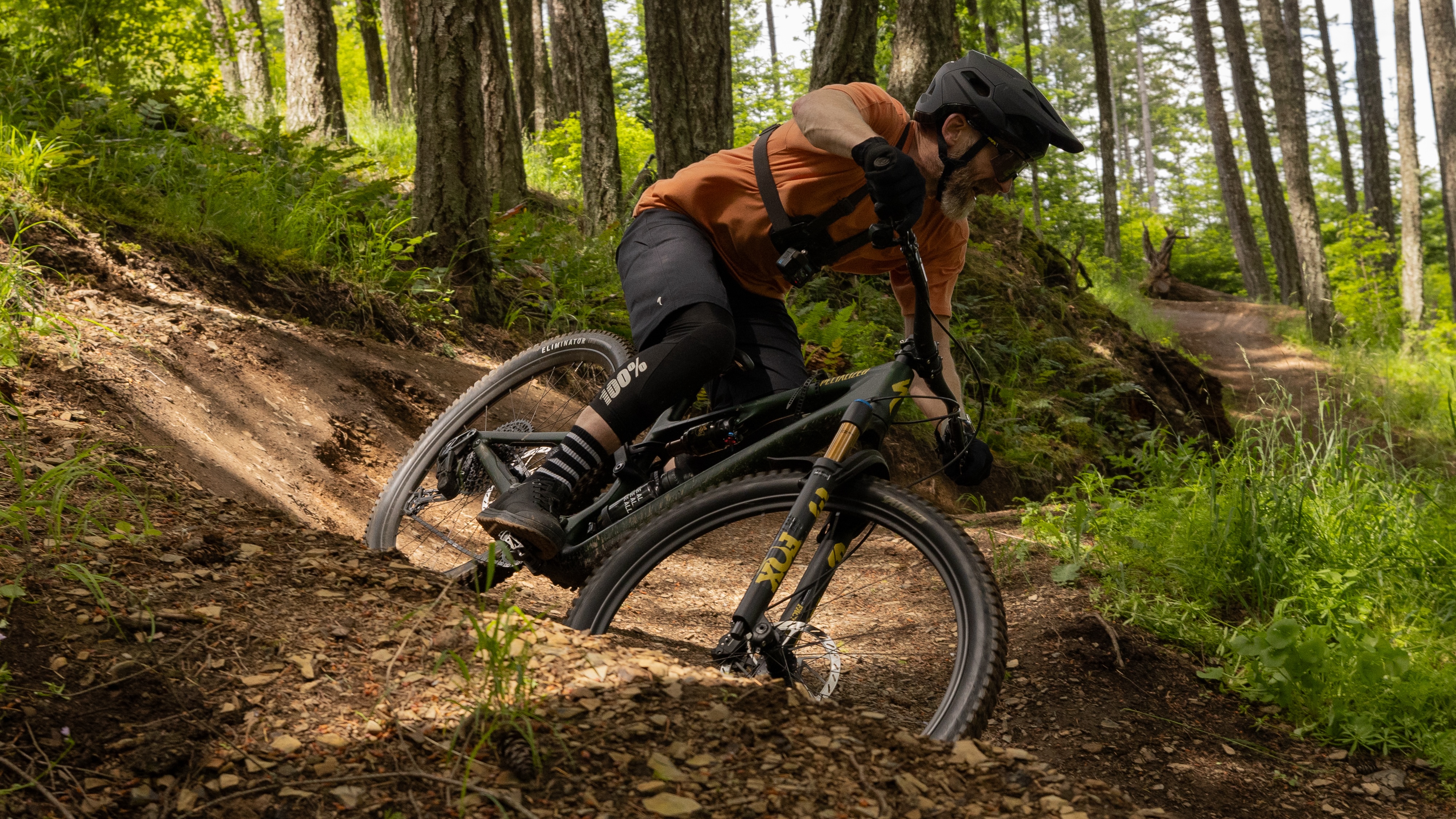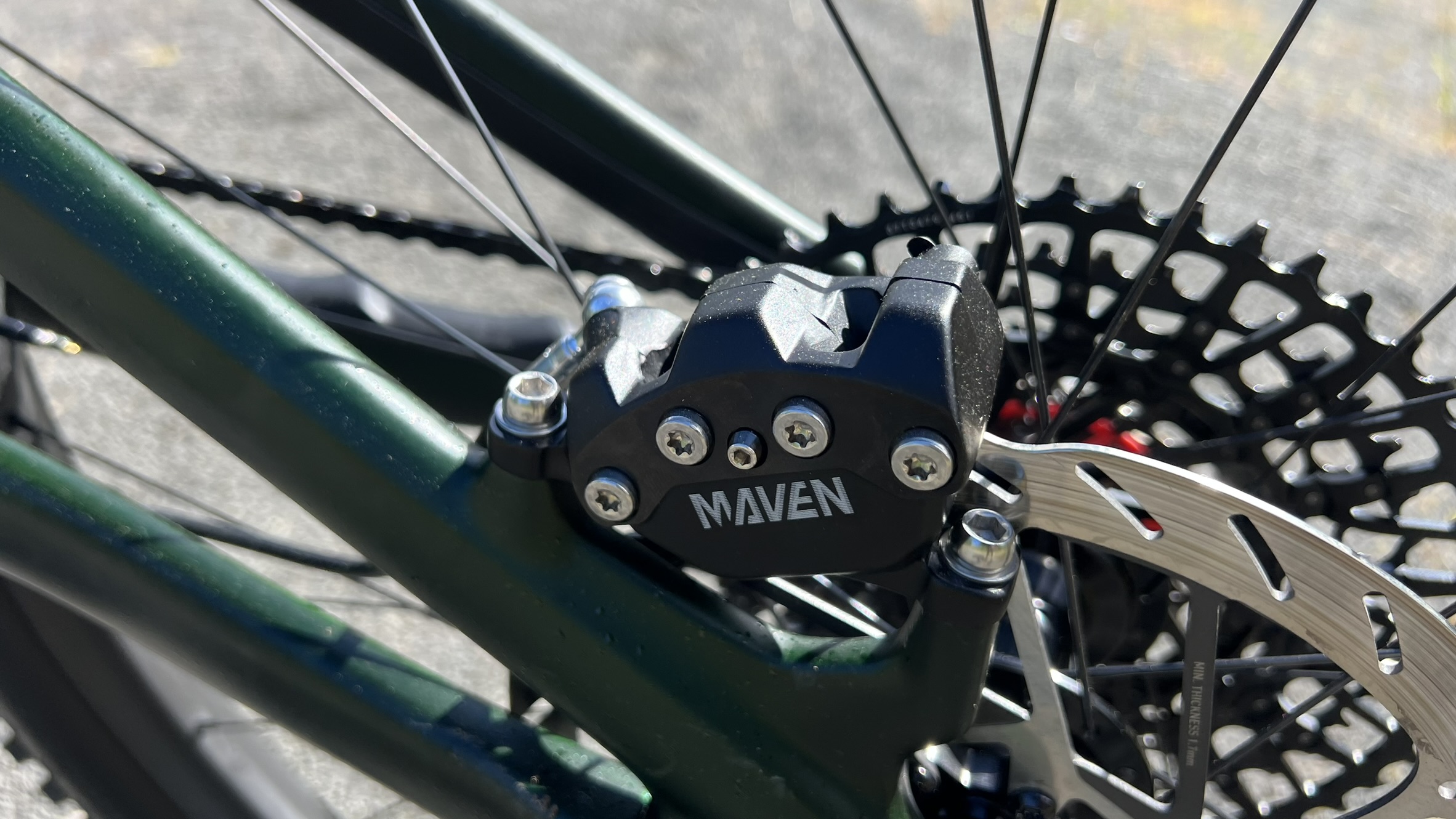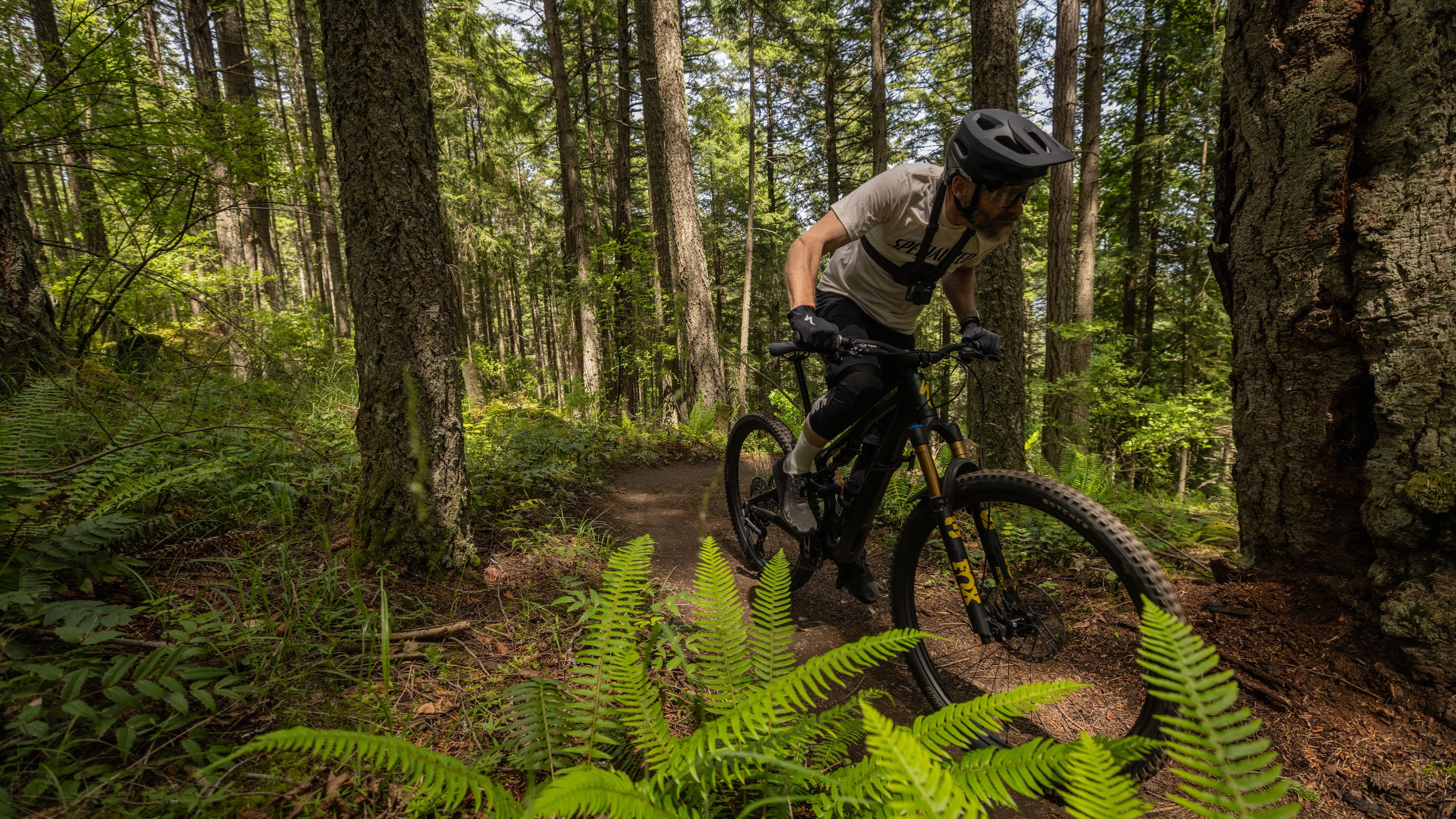
Specialized’s Stumpjumper has been a mountain bike benchmark since it appeared in 1981 and the current Stumpjumper Evo is an incredible all-rounder and one of our best trail MTB recommendations. So what has the US brand done with the all-new Stumpjumper 15 to make it even better and has it worked? I've been testing the Pro version with its new "Genie" shock setup to find out.
Design and geometry
The Specialized design team says they started with a complete clean sheet for the new Stumpjumper and considered every possible frame layout and suspension packaging solution. You probably wouldn’t realize though as it basically looks the same as it has for over a decade, with Horst link (chain stay mounted rear pivot) ‘FSR’ rear end driving a top tube underslung shock via a short bridging horseshoe. The frame has lost the asymmetric ‘sidearm’ strut of the previous generation bike to make room for the new fat can "Genie" Fox Factory shock (more on that later). As a result the whole FACT 11m carbon frame and alloy linkage has been restructured to retain a similar stiffness to the Stumpjumper Evo as Spesh was really happy with the ride dynamic of that chassis. The linkage is now slimmer and single-sided to reduce transferred side load to the shock though, while the SWAT 4.0 downtube hatch has been refined for a neater, tighter fit on what’s already the original and best internal storage system around. That keeps frame weight within a few percent of the claimed 2,750g of the XC-orientated Specialized Evo 8 and gets the same lifetime warranty on manufacturing faults and suspension bearings. The rear brake routing is all sleeved and pipes out of the frame front for trauma-free headset changes too.
That’s crucial as Stumpjumper 15 uses the same switchable headset cups as the previous Stumpies to allow a head angle range of 63 to 65.5 degrees from the default 64.5 degree setting it comes in. A reversible rear shock mount helps with that adjustment and the rear chain stay pivot has a Hi and Lo position for altering ride height by 7mm. That also maintains geometry if you decide to use a 27.5in ‘mullet’ rear wheel, and that’s the format S1 and S2 sized bikes come in anyway, with S3 to S6 coming with 29er wheels front and rear as standard. Specialized also uses four different chain stay lengths as a nod towards proportional handling balance.
Otherwise the S4 (aka size large) I was testing has a 475mm reach, 640mm stack, 125mm head tube length, 337mm bottom bracket height (38mm drop) and 1,244mm wheelbase. A super short 425mm seat tube length opens up long stroke dropper use with a 185mm Bike Yoke model fitted to my test bike.
Specialized has taken the radical decision not to give the new frame any entry ports or routing for conventional wired gearing though. That means it's currently SRAM AXS only for transmission choices – which is presumably why SRAM launched its new S-1000 AXS Transmission option just a couple of hours before Stumpjumper dropped.
The rear brake mount is a direct fit for 200mm rotors too, which seems overkill when most bikes already get the massively powerful Maven anchors as standard.

Suspension
Given that changing the excellent ride dynamics and adjustable geometry of the previous Stumpjumper Evo would have been a chump move, Specialized has looked to an exclusive new Fox ‘Genie’ shock built to their own unique design. While the execution has taken some smart thinking and lots of materials experimentation, the principle behind the Genie is pretty simple. It slides a high-volume air can over a standard volume shock body. The two combine to effectively create a massive single chamber for the first 70 percent of the stroke, but at that point the ‘Genie band’ (an extended piston sleeve) closes off the outer can. That means the last 30 percent of the stroke is supported by a much smaller volume, far more progressive air chamber. By using a split ring secured design, the Genie sleeve can be slid off and then back on super easily. This allows you to add up to four, two-piece clip spacers to change the volume and therefore the amount of plush the Genie system adds. You can also add conventional eyelet spacers into the inner can to change baseline volume too. Like most Specialized shocks, the Genie also has its own ‘RX’ compression damping tune, this can be altered on the fly via a two-position compression lever with micro-gate adjust for the open position.
The Ride Dynamics team has also tweaked the suspension kinematics slightly too, reducing anti-squat compared to the current Stumpjumper Evo, but keeping it higher than the Stumpjumper. Rear wheel travel drops 5mm from the Evo to 145mm, but that’s 15mm more than the previous ‘flex stay’ Stumpjumpers.

Components and build
Matching the Factory spec Genie shock is a Fox 36 Factory fork with with 150mm of travel (10mm shorter than Stumpjumper Evo). The bike I rode had a GRIP2 damper too, while production bikes will have the latest GRIP X2 damper.
Stop and go is a sturdy SRAM mix. The super powerful Maven Silver brakes get 200 and 180mm rotors. The XO chainset has bolt-on bash guard segments and it’s the metal caged XO T-Type AXS wireless rear mech at the rear.
The Specialized own-brand kit is more lightweight focused, however. This includes the excellent Traverse SL II broad lip rimmed wheels, Traverse SL carbon bar and titanium rails on the Bridge Expert MIMIC saddle. The Butcher front and Eliminator rear tires are Grid Trail carcass rather than the tougher Grid Gravity construction. That put weight of my test bike at 14.1kg, undercutting competitors like Santa Cruz’s Hightower, Canyon’s Spectral CF LTD and Yeti’s SB140 by several hundred grams in similar spec builds.

Ride, handling and performance
I’ll apologize now if the following test section sounds more analytical and process driven than my normal characterizations. However, with six different geometry settings and four different Genie spacer setups to work through, the two-day test session I had in Conichawan Bay, Canada, was seriously intense. I’ve spent a lot of time on various versions of the Stumpjumper Evo though, so the overall handling vibe and dynamic balance of the new bike was reassuringly familiar. Regardless of Specialized’s stats it does feel a little sharper up front, but that’s potentially due to the shorter fork and being able to get the seat lower is a body weight mobilizing bonus. Whatever the reason, where the Evo could sometimes feel flaccid, the new Stumpjumper felt like it had a healthier blood pressure to me.
The broad but grippy Traverse SL wheels flattered the T9 front and T7 rear tires on a range of baked to hero dirt trail conditions too, so it was easy to push hard during testing. I also switched to a mullet rear wheel with a Gravity Grid Cannibal on the rear for the second morning on the bike so I could really hammer it without worrying about blowing the rear rubber. I preferred it in stock spec with twin 29ers though as it felt more poised and planted overall as well as making the repeat climbs the endless sessioning demanded significantly easier.
Given the similarity between the new bike and its predecessors, Specialized has thrown a lot of science at proving there’s a significant performance increase from the Genie shock. That includes “16.3 percent bump management” than the Evo. Partly because it uses the same amount of travel as the Specialized Enduro and 13mm more than the Evo (100mm V 87mm) to absorb the same impact force. But also because it apparently gives “39 percent fewer severe bottom-out events compared to a standard air spring”. Brake sensor sampling shows rear wheel contact was 57 percent more consistent on descents for increased traction. They even included a full ‘white paper’ of data to back this up (but to be totally honest, I’ve not read it).
That’s because working through all the various settings on the Genie makes it clear Specialized and Fox have delivered something very impressive. With no spacers in the can, the Genie feels super plush, sensitive and genuinely coil-like in the way it sucks the bike down onto the ground through turns. While it’s definitely keen to use a lot of stroke a lot of the time, it still collected bigger drops with smooth composure and didn’t buckaroo me over the bars when I badly cased an off-piste gap. It’s worth noting that there weren’t many roots or rocks on the well-groomed trails, but the slightly backed off anti-squat on the suspension means I’m not worried about nasty surprises if you do take your Stumpy somewhere more slappy. In other words, full open can works great for wilder, rougher, steeper situations where maximum grip and connection are crucial and you want a bike that feels like it’s got 160mm of travel not 145mm.
Progressively adding spacers unsurprisingly increases the mid-stroke support and creates a tighter, tighter feel. That lets you push harder through smooth berms and back sides, as well as putting more power through the pedals without obvious wallow. In fact, despite the lower anti-squat numbers, the Stumpjumper 15 feels tauter and more responsive on the gas than the Evo, and a lot more rewarding to load watts into than the previous Stumpjumper. Running the shock with a full can (four spacers) effectively turns it into standard shock for proper sprint and pump trail hustling like a short travel bike. Add the already low weight of frame and wheels and a relatively fast rolling rear tire, and you can set up the Stumpjumper for really rapid and efficient ground covering – if you’re on a more XC rather than Xtreme style mission. The more you fill the Genie can though, the more you lose you the bonus traction benefits so my preferred setting would be between one (which is how it comes) and three spacers for my home trails depending on the vector of the day.
In terms of equipment, the most relevant thing is that what I initially thought was an excess amount of stopping power from the Maven brakes, soon became very much appreciated as test speeds and technical changes escalated through the two days. Conversely that raised more concerns about the tires and while I didn’t roll the rear or slide around too much on the T7 rear, I can see more aggressive riders moving to Grid Gravity rubber and treads like Cannibal and Hillbilly.

Verdict
Specialized had a seriously hard job on their hands preserving what made the existing Stumpjumper Evo so brilliant, while also pushing the new Stumpjumper forward enough to make it worth buying. The bottom line is that they’ve done a brilliant job. It packs all the geometry adjust versatility and internal storage practicality of the previous two bikes. It then wraps the whole performance envelopes of what were two very different vibing machines into one shock. A shock that you can reconfigure from genuinely coil-like to XC efficient in a couple of minutes. They’ve sharpened up things like the internal storage while keeping weight lower than most of its competitors. The fact it pedals and pushes on through technical terrain far better than the previous Stumpjumper offsets the fact that bike was lighter and with the Epic Evo now getting more capable that gap has pretty much closed anyway.
While there are some people who won’t need as much brake, or might want tougher tires and a longer fork, Specialized was always going to have to pin the tail on the donkey somewhere and I still think the overall package kicks ass for most potential Stumpjumper riders. If the Pro stretches your budget there are $6,500 Expert and $4,500 Comp options too.
The Evophant in the room
Let's be real here, in terms of geo, practical features and ride vibe, the new Stumpjumper is very very close to the previous Stumpjumper Evo. So if you don't need the extra adjustment of the Genie shock, then you could potentially pick up an Evo for a much better price and not really miss out on the trail. A quick scan of the web revelas that a lot of those big discounts click through to a very limited range of sizes and colours though, so if that's your plan, don't hang about.
Tech specs: Specialized Stumpjumper 15 Pro
- Discipline: Trail
- Price: £7,500 / $9,000 / €9,500
- Head angle: 63 / 64.5 / 65.5 degrees
- Frame material: Specialized FACT 11M carbon fiber
- Fork: Fox 36 Float Factory GRIP2 150mm travel
- Shock: Fox Specialized Genie Factory 145mm travel
- Sizes: S1 to S6
- Weight: 14.1kg (S4 tested)
- Wheel size: 29in
- Chainset: SRAM X0 170mm arms with DUB bottom bracket.
- Rear mech: SRAM XO Eagle AXS T-Type
- Shifter: SRAM XO Eagle AXS
- Cassette: SRAM Eagle XO 12-speed 10-52T
- Brakes: SRAM Maven Silver, 4-piston hydraulic disc brakes with 200mm rotors
- Tires: Specialized Butcher GRID TRAIL T9 29x2.3in front and Specialized Eliminator GRID TRAIL T9 29x2.3in rear
- Wheels: Roval Control SL 29in with Torque Cap front adaptor
- Bars: Roval Traverse SL 800 x 35mm
- Stem: Industry Nine 40 x 35mm
- Grips: Deity Lockjaw
- Seat post: Bike Yoke, Revive Max 185mm
- Saddle: Bridge Expert with MIMIC, Hollow Ti rails







